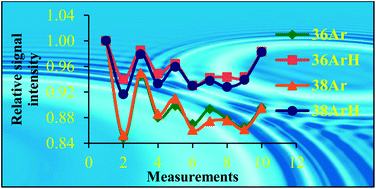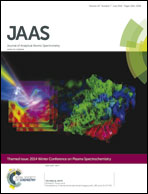The interference standard method: evidence of principle, potentialities and limitations†
Abstract
The interference standard (IFS) method is a calibration approach recently proposed to overcome polyatomic interference in quadrupole-based inductively coupled mass spectrometry (ICP-QMS). Based on the hypothesis that interfering ions and IFS species such as 36Ar+, 36ArH+ and 38Ar+ present similar behaviors in the plasma, the IFS method has successfully been applied in several analytical procedures. In this work, analytes, interfering ions and IFS species are monitored by high-resolution double focused sector field inductively coupled plasma mass spectrometry (HR-SF-ICP-MS) to achieve a better understanding of the mechanism of the IFS method. The relationship between accuracy and signal variations for interfering and IFS species is explored. Critical cases of polyatomic interference in elemental determination using quadrupole-based ICP-MS instruments, such as the ones observed for 39K+, 75As+, 28Si+ and 32S+, are evaluated. The limitations of the IFS method and the conditions under which it can be most effective are discussed. This is a simple and efficient method that could be extended to other analytical techniques provided that interfering and IFS species present similar signal behaviors.

- This article is part of the themed collection: 2014 Winter Conference on Plasma Spectrochemistry

 Please wait while we load your content...
Please wait while we load your content...